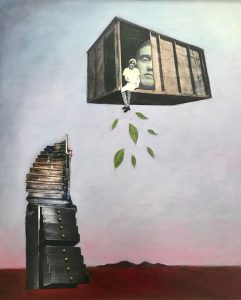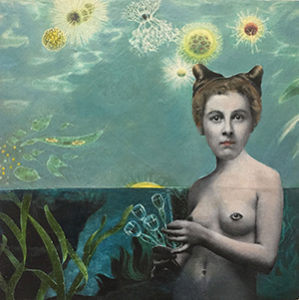November 22 – December 14, 2019 | Suzanne Sbarge: Dovetail
About the work Suzanne says, “Some of the earliest examples of dovetail wood joinery are found in ancient Egyptian burials, places where body and spirit re-aligned and transformed. The hybrid characters in my work are similarly in states of flux, emerging from the unconscious and becoming something real, or exiting the limitations of the natural world and becoming new beings in new dreamscapes.”
The juxtaposition of paint and collage gives a sense of altered vision. This “collaged state of mind” – the dovetailing of the real and the surreal – is what Suzanne Sbarge looks for. Ever-present are the dualities of familiarity and otherworldliness, interior and exterior space, domesticity and freedom, sky and earth, real and imagined.
Opening Reception Friday, November 22, 2019 from 5 to 7pm.
Suzanne Sbarge: Night Bird Through Opera Glasses Essay by Mary Anne Redding
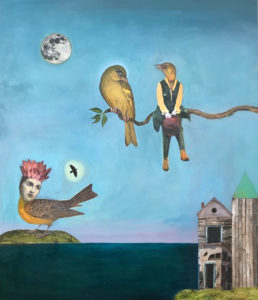 By Mary Anne Redding, Curator and Director of Turchin Center for Visual Arts
By Mary Anne Redding, Curator and Director of Turchin Center for Visual Arts
Once upon a time, when women were birds, there was the simple understanding that to sing at dawn and to sing at dusk was to heal the world through joy. The birds still remember what we have forgotten, that the world is meant to be celebrated.
—When Women Were Birds by Terry Tempest Williams
The artist leaves the arts administrator’s world of rational organized thought, retiring to her sacred nest where she spends the evening spinning secrets—strange surrealistic worlds inhabited by isolated dreams of Hieronymus Bosch conflated with the words of her grandfather and great grandfather, both scribal rabbis who passed down their love of mysticism to the cherished inheritor of their ageless knowledge.
Plant life, butterfly wings, iridescent pearls, sea creatures, land animals, and beautifully strange birds become the habitat for metaphors of fertility, regeneration, and both spiritual and sexual freedom. Suzanne Sbarge’s fascination with birds is inspired by the paradox between: “their freedom of flight and the stability of their domesticity.” The artist, through her acts of creation, undergoes a metamorphosis through divine agency, experiencing an awakening, an obsession, the hint of a tease, an ancient myth, an interrogation, a celebration of a life of hope in the midst of the chaos of the mediated world of nature—a world under increasing siege so poignantly revealed in Flood Song and Island.
Suzanne’s painted collages open doorways into the ambiguous space of the night: dreams brim with narrative probability yet remain resistant to literal interpretation. There are libraries of potential in a single image—the lyricism of worlds breaking apart to be restructured into new impossible possibilities, the lost physicality of paint and paper in our sterile digital age—memories and the songs of the birds. Music is important, a quiet reference to the self: the artist plays the accordion (a secret reveled) and married into musical royalty. The song continues.
I live with several of Suzanne’s collaged paintings; they haunt my nights and enrich my days like Margo Timmon’s lyrics, reminding me of connections that lie beneath the waves as rock becomes my anchor and bird becomes my dream, offering me endless skies to search for buried memories of art, experience, a shared passion for the desert and it’s ancient wisdom that draws us together through space and across time: I succumb to an alchemical longing.
Scientists have recently discovered a surprising super-massive black hole that estimates with great accuracy when starlight first filled our universe. On earth, we have always looked to the stars to find out where we are. Suzanne’s paintings speak to this searching. In Constellation 2, starlight cyclones through the tiny house and tunnels into the earth, providing a map for knowing where we are. Similarly, the figures in Clay Pigeon and Leopard II are bound to the map beneath their feet but look to the sky for a different kind of knowledge. Suzanne’s art reminds us indeed, that our world in all its mysteries is meant to be celebrated.
10 December 2017
Suzanne Sbarge: Pasatiempo Cover Story December 1, 2017
A fantasticallly insightful cover story by Jennifer Levin appeared in the Pasatiempo (the Santa Fe New Mexican’s art publication) on December 1, 2017, in conjunction with the opening of her exhibition Meta/Morph at Turner Carroll. Levin details Suzanne Sbarge’s background as the daughter of Jewish refugees, on a Holocaust survivor. Sbarge’s grandfather and great grandfather were both rabbis, who infused her early life with an innately mystical quality. Sbarge takes her intuitive mysticism, as well as her profound study of Jungian archetypal psychology, into her artistic world. She applies this primal mystical consciousness to her collaged images of animals and humans, thereby presenting her belief that all living beings are intuitively connected. Sbarge makes a fascinating connection between our interconnected consciousness as humans with the consciousness of animals in her statement: “Animals are part of human consciousness. As we lose animals, we are losing parts of our own consciousness.”
You can read the full text of Levin’s fabulous article here.
1 December 2017
December 1 – 20, 2017 | Suzanne Sbarge: Meta/Morph
New Mexico artist Suzanne Sbarge has led a fascinating artistic life. Her mother’s family emigrated from France during World War II, ending up in a concentration camp on Martinique. She grew up in Connecticut, and went to college in New York. As an art curator and activist herself, Sbarge created the respected 516 ARTS gallery in Albuquerque, which regularly receives international attention for its exhibitions.
Suzanne’s own artistry is highly intellectual, curiously combined, and finely crafted, as is her life. She has created a “bestiary” of combined animal and human forms, collaged together from the materials of her own existence.
Suzanne Sbarge gallery talk date will be announced soon—stay tuned!
Opening Reception Friday, December 1, 2017 from 5 to 7pm
Sbarge 2017 Meta/Morph-press releaseMarch 8 – 31, 2017 | Matri-ART-y: Women’s’ March on Art!
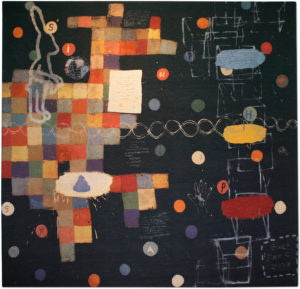
Squeak Carnwath
In a civilization where more than 51% of the population is female, yet 96% of exhibition space is given to men, it’s time for a change. In honor of National Women’s History Month and in celebration of uniquely brilliant female perspective, Turner Carroll features important women artists all month. Artists include an international roster including Nina Tichava, Raphaelle Goethals, Hung Liu, Squeak Carnwath, Karen Yank, Jamie Brunson, Mavis McClure, Jenny Abell, Suzanne Sbarge, Holly Roberts, and Brenda Zappitell.
Opening Reception Friday, March 10, 2017 from 5 to 7pm
[n.b. that this event takes place in Santa Fe]
CULTURE SHOCK
Adventures in Birdland—Suzanne Sbarge once again uncages her otherworldly birds for a one-woman exhibit opening this week at Mariposa Gallery (3500 Central SE). Her collage paintings conjure up dreamy sequences that are simultaneously homey and adventurous. The new show is called Breathing Space. If you haven’t seen Sbarge’s work, you’re advised to attend the reception this Friday, March 2, from 5 to 8 p.m. If you have seen her work already, then I’m guessing your calendar is already marked. The show will run through the end of the month. For details, call 268-6828.
Sarah Silver of the Stephen Petronio Company will perform at this year’s Global Dancefest.
Bigger, Better—For the seventh year in a row, Global Dancefest is back, bringing the best in contemporary dance to Albuquerque. Six performances will take place between March 7 and March 14, and this year there will also be an accompanying visual art component with an exhibit by Taos artist and poet Minori Yata. We’ll have more details in next week’s issue. If you don’t feel like waiting around, log on to www.vsartsnm.org for more information.
On the cutting edge: Exhibition Showcases Group of Innovative Collage Artists
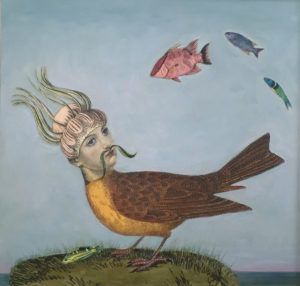
Mustache
ALBUQUERQUE, N.M. — The Mariposa Gallery, now celebrating its 42nd year, is hosting “ORBIT,” a visually provocative seven-artist collage exhibition inspired in part by dada, surrealism and postmodernism.
The show is the result of a series of gatherings of collage artists who formed a loosely defined support group to share ideas and techniques. The artists chose the same one or two images based on vintage photographs of the moon as a theme for the exhibit.
The group includes Roberto Appicciafoco, Zach Collins, Jeff Drew, Kelly Eckel, Valarie Roybal, Suzanne Sbarge and Greg Tucker.
The broad variety of approaches and use of the lunar pictures reveal how creativity can be beautifully enhanced rather than squelched by limitations.
The range covered in the 22-piece collection runs between pure collage works without the obvious hand of the artist to predominantly hand-painted pieces like Sbarge’s offerings and Tucker’s mostly wood construction.
Although Pablo Picasso and Georges Braque coined the term “collage” from the French word “coller” (to glue) in the early 20th century, the technique of gluing overlays of paper and imagery together actually began in China around 200 BC. From there, the technique traveled to Japan by the 10th century and finally arrived in Europe during the 13th century.
Until Picasso and Braque reinvented collage as a modernist fine arts technique, collage was a decorative craft mostly practiced by women.
Appicciafoco, who considers collage to be a liberating process, is inspired by music, films and everything else he sees. His well-executed images – such as the truly stunning “Honeymoon,” an organic view of space, and “Rocket Girl” – have the look of carefully designed pop-surrealist paintings with hints from graphic artists like Andy Warhol of course sans soup cans and scrub pad boxes.
Collins works in miniature to create constructivist compositions that are the most successful abstract miniatures I’ve seen. I love the fact that a large section of the moon can be captured in a less than 4-inch rectangle. Collins has a great sense of composition and scale. His earth-tone palette lends a tasteful touch as well.
Drew presents a series titled “Secret History of the Moon,” which includes an image of a woman about to bite into the Earth as she holds our world in her well-manicured hand, replete with brightly polished fingernails.
The mandala form inspires Eckel in “Patterns,” a dynamic design with embellishments.
Roybal offers “Saturn Man” to the fray, a nicely designed juxtaposition between the business-suited human and his saturnine head.
I have not always been a fan of works by Sbarge, but over the years I have come to truly appreciate the careful artistry that she puts into her collages and have turned a corner regarding her beautifully executed selections.
Besides a great sense of design and color, her work has evolved from early inspirations drawn from her mentor, Holly Roberts, into a personal iconography that is most often breathtaking. Three pieces drew my attention. “Wild Turkey,” in the gallery but not the show, “Arctic Owl” and “Duck” are all near perfection of technique and mysterious.
Longtime newspaper, magazine and book illustrator Greg Tucker, who studied fine arts from childhood through university, is offering “Lunar Rhythmic Device” a beautifully rendered mixed-media sculpture.
Tucker’s four-wheeled “machine” features a wind-up metronome that emblemizes the moon’s regular influence on earthly events like ocean tides, women’s menstrual cycles and, according to his artist’s statement, creativity among artists and scientists.
Although these connections may indicate a modicum of lunacy, the show makes one wonder whether Allen Ginsberg wrote “Howl” under the influence of a full moon. It’s a great show, and the gallery is chock-full of other notable creations.
Blue Mesa Review 22
Edited by Chris Wrenn
Blue Mesa Review, the literary magazine of the University of New Mexico’s creative writing program, continues its tradition of publishing outstanding and innovative stories and poems along with interviews and essays that serve as a forum for thoughtful discussion on a broad range of issues, ideas, and literature.
Issue #22 contains the very best and most exciting work available from across the United States. This issue includes fiction from Milagro Beanfield War John Nichols as well as an exclusive interview with the author by Greg Fraser. You’ll also find fiction by Yelizaveta Renfro, Mary Helen Specht, Rachel Newcomb, Tatjana Soli, Jaclyn Dwyer, Melissa Olson-Petrie, and 2009 Fiction Contest Winner Steven Ramirez.
Poets in #22 include Maureen Seaton, Jenny Hanning, Martin Arnold, John Nizalowski, Keith Montesano, Jared Walls, and B.J. Best. There are essays by Gary Fincke and Paul Bogard, as well as stunning visual art by Suzanne Sbarge.
Published By Blue Mesa Review
April 14 – 17, 2016 | Turner Carroll at the Dallas Art Fair
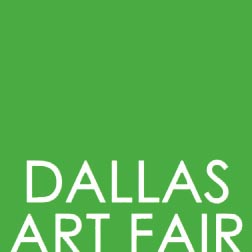
Dallas Art Fair
Located at the Fashion Industry Gallery, adjacent to the Dallas Museum of Art in the revitalized downtown arts district. Featuring new works by gallery artists Fausto Fernandez, Hung Liu, Squeak Carnwath, Drew Tal, Jamie Brunson, Rusty Scruby, Edward Lentsch, Wanxin Zhang, Suzanne Sbarge, Karen Yank, Scott Greene, Holly Roberts, and more! Fair hours are Friday and Saturday, April 15 and 16 respectively, from 11am to 7pm, and Sunday, April 17 from 12pm to 6pm, with an opening preview gala Thursday, April 14.
A link to the Dallas Art Fair is here.
Albuquerque Museum offers ‘Crowdsourced’ exhibition of paintings, sculpture, ceramics
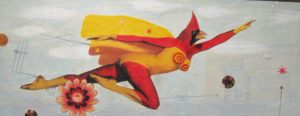
Suzanne Sbarge – Cardinal
In the spirit of Forrest Gump’s assertion that “life is like a box of chocolates – you just never know what you’re going to get,” the Albuquerque Museum invited 2,000 people to visit 97 local artists’ studios over three consecutive Saturdays and pick their favorites.
The result is “Public Selects: a Crowdsourced Exhibition” with works from 12 studios by 13 artists in a sampler of media chosen by 1,100 respondents.
The winning artists are Jane Abrams, Timothy Cummings, Kristin Diener, Elizabeth Fritzsche, Thomas Christopher Haag, Ed Haddaway, Kei and Molly Textiles (Kei Tsuzuki and Molly Luethi), Jami Porter Lara, Orlando Leyba, Dennis Liberty, Suzanne Sbarge and Kevin Tolman.
Art Forum: Pasture II by Suzanne Sbarge 28 July 2015
THE Magazine asked a clinical psychologist and two people who love art for their take on this mixed-media piece—Pasture II—by Suzanne Sbarge. They were shown only the image and were given no other information.
Many peaceful images are layered inside this bucolic scene. While flowers symbolize a plethora of topics (e.g., romance, sympathy, commitment, friendship), the image of a beautiful young woman holding a flower reminds me of the 1960s hippie movement. Bulls are typically thought to represent strength, power, and fertility. Yet they are resting comfortably here. It seems the animals feel safe enough to let their guard down. A bluebird emerges from the woman’s eye like something from Greek mythology. Could this woman be the Goddess of Harmony? Bluebirds are known to symbolize happiness, hope, and the spring season in various cultures. Alternatively, this face may represent Mother Nature presiding over her creation. A mist appears like a tranquil glaze over the scenery. Its presence suggests dawn, an emotionally and physically quiet time. Psychologically, houses are thought to symbolize the psyche and even the personality. They are common dream images. Perhaps this painting is the artist’s dream. If this is true, we are seeing his or her wish for peace.
—Davis K. Brimberg, Ph.D., Clinical Psychologist
In spite of the tight fence around Mother Nature’s delicate neck, She looks back at us with knowing, smiling eyes. While humans attempt to separate themselves from Her universe, She rises transcendent and free. Although disguised behind a flower-mask, Nature continues dominant above humankind’s naïve attempts at taming Her. Poised over the landscape of an idealized bucolic scene stolen from a children’s fairytale, Nature glows triumphant. The pastoral illustration fades into the background. Whatever contentment is depicted within it exists only because of Nature’s blessing. She is the ultimate landlord—renting space on the planet as humankind builds houses soon to become vain towers of Babel. Mankind attempts to organize Nature, but his quaint country roads soon turn into ugly, brutal express highways made possible by his disastrous exploitation of fossil fuels. In order to assure his food supply, His simple domestications will turn the rainforests into lifeless dust. All his efforts to exploit Nature will be as the swallow on the wing—fleeting and incomplete.
—Gershon Siegel, Writer
The cut-out and chalked-over photo of a young white woman’s face stares out at us from behind a flower and a bird, and from within Currier & Ives’s American Homestead Summer. The shadow of her neck and shoulders embrace the pastoral scene. She both emerges from and dominates the scene. The sharpest shapes in the piece are the corners of her eyes and lips, the arrow of the cutout cheek, and the bird’s wingtips; all causing my eye to linger and return to the upper left of the collage. But, her blank expression only says, “I am here.” I then explore the pastoral landscape for meaning. The Homestead series of 1868 evoked quintessential American seasonal allusions and illusions, and likely provided the comfort of escape to many white citizens just a few years after the end of the Civil War. Back to the face: could it be Nicky Hilton (or Paris?) of the Hilton Hotels family, so white, so rich, so pretty, staring out at me from within the idyllic American countryside? The fullness of an American summer’s bounty, pretty lips, young white flesh, a red blossom, and a blue bird: how comforting. Unpretty and awkward magazine cutouts glued onto a reproduction of an old lithograph of cows, grass, and trees: how odd. Young, pretty, and innocent questions like “I see red, white, and blue, how ’bout you?” wafting over the clean green setting like a white rich shadow after a civil war.
—Lisa Pelletier, Graphic Designer
A Chat with 516 ARTS Director Suzanne Sbarge
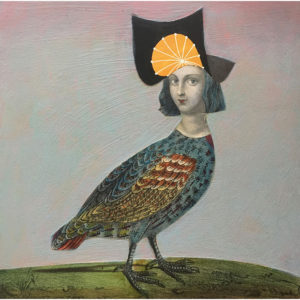
Green Eyed Bird
Since you only have until June 1 to catch Flatlanders & Surface Dwellers before they take it down, Pyragraph rang up 516 ARTS director Suzanne Sbarge in Albuquerque for a quick chat to get caught up.
Pyragraph: How did Flatlanders & Surface Dwellers go?
Suzanne Sbarge: It’s been great, there’s been a lot response from the general public; people have really responded to the tactile nature of the show and the colorful quality of it. There’s visually enticing work in the show and artists especially have enjoyed it because there’s a real feel for the making of the show.
Pyragraph: Will you have any programs or workshops going on while you’re switching shows during all of June?
Suzanne Sbarge: We won’t because it’s such a big process to take down one show and pick up another. But June 29th will be a very big day, which is unusual for us. Usually we just have an opening, but he’ll have the opening, a panel, and some events at the farmer’s market. It’s the first time we’ve ever done it. It’s a print-making action, a print blitz, at the Downtown Grower’s Market, at 9 a.m. And then we’ll have a parade of flags at 11.
Pyragraph: Were you there for Nicole Dextras’ talk on May 11 (Salvador Dali’s birthday!)?
Suzanne Sbarge: It was wonderful! It was a relatively small audience but an enthusiastic audience. There were a lot of gardeners there! Her talk was fascinating. She brought up many interesting issues about sustainability and the production of clothing and the economy and the environment; also, very humorous and imaginative the way she has carried out actions in community. The dresses she makes, they’re sculptural objects she has models wear and they go out into the community and interact with the public in interesting ways.
Pyragraph: So, 516 ARTS has full Native-American-related programs all summer? Is this art show linked to any bigger movement?
Suzanne Sbarge: For us, it’s part of a two-season series called Placed/Displaced, a series of exhibitions and programs that explore cultural identity through place. Our Fall show is about the U.S.-Mexico border. The Air, Land, Seed exhibit downstairs is part of something these artists and curators are doing at the Venice Biennale that have gone for many years in different configurations at the Venice Bienniale. Air, Land, Seed was made for Venice Bienniale and 516. We have resident artists John Hitchcock and Emily Arthur, and it’s the first time we’ve done it with the Visual Artist Network (we are new members). It’s a prestigious national organization and they help produce residencies. (In) the week leading up to the opening, the resident artists are doing a printmaking banner project. People can come to the gallery while they’re working and participate and observe. They’re working in the Native American tradition of giveaways and they give these prints away.

